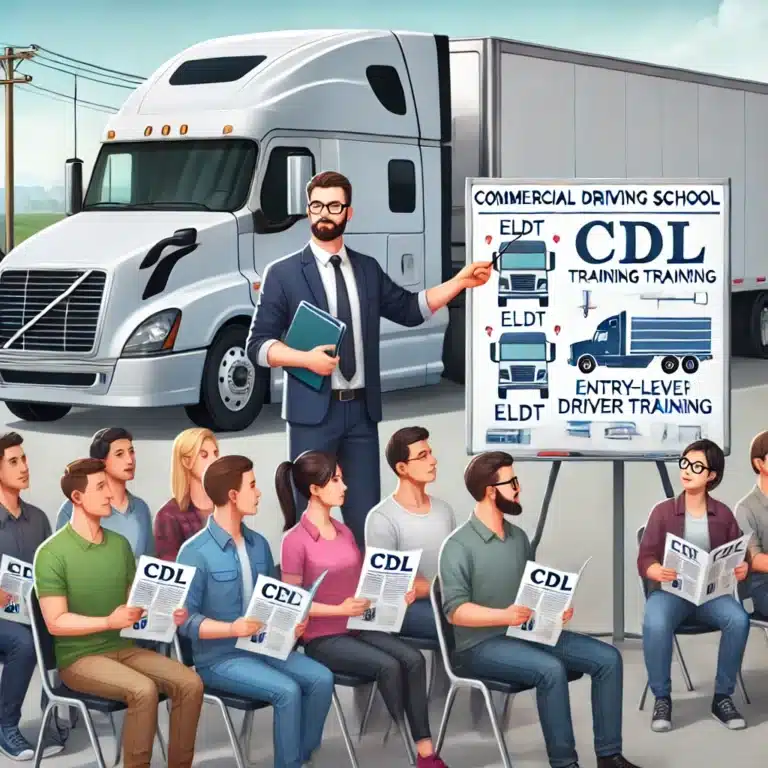ELDT Requirements Explained: Step-by-Step Guide to Entry-Level Driver Training for CDL Applicants
 The Entry-Level Driver Training (ELDT) process is a vital step for anyone embarking on a career in commercial driving. Established to raise safety standards and ensure consistency in driver education, the ELDT process provides comprehensive training for prospective Commercial Driver’s License (CDL) holders. Below is an in-depth look at the ELDT process, its components, and its importance.
The Entry-Level Driver Training (ELDT) process is a vital step for anyone embarking on a career in commercial driving. Established to raise safety standards and ensure consistency in driver education, the ELDT process provides comprehensive training for prospective Commercial Driver’s License (CDL) holders. Below is an in-depth look at the ELDT process, its components, and its importance.
What Is ELDT?
Definition and Purpose
The ELDT process stands for Entry-Level Driver Training. It represents a federally mandated framework designed by the Federal Motor Carrier Safety Administration (FMCSA) to ensure that all new drivers entering the commercial driving field receive standardized, high-quality training. The goal is to reduce accidents and improve overall road safety by equipping drivers with the necessary knowledge and skills before they start operating commercial vehicles.
Regulatory Background
Implemented to replace older training guidelines, the updated ELDT requirements became effective as part of a broader effort by the FMCSA to enhance safety on the nation’s highways. These changes reflect a commitment to modernizing driver education in line with current industry practices and technological advances.
Why Is ELDT Important?
Enhanced Safety
By providing a uniform curriculum, the ELDT process helps ensure that all new drivers are well-prepared for the challenges of operating large vehicles. This training covers essential topics such as vehicle inspection, safe driving practices, and maneuvering techniques, all of which contribute to a reduction in on-road incidents.
Career Readiness
Completing ELDT not only fulfills a regulatory requirement but also builds a strong foundation for a successful career in trucking or passenger transport. Employers recognize the value of standardized training, often preferring candidates who have completed an FMCSA-approved ELDT program.
Legal and Regulatory Compliance
For aspiring commercial drivers, adhering to ELDT requirements is a crucial step toward obtaining a CDL. Failing to complete the training could result in delays or complications during the licensing process, making it an essential part of your professional journey.
Components of the ELDT Curriculum
The ELDT curriculum is comprehensive and designed to cover all aspects of commercial driving:
-
Classroom Instruction:
Drivers learn about federal and state regulations, vehicle systems, and safety protocols. This theoretical knowledge is essential for understanding the complexities of commercial driving. -
Behind-the-Wheel Training:
Practical training sessions allow drivers to gain firsthand experience operating commercial vehicles. This portion of the program focuses on maneuvering, handling different types of vehicles, and executing pre-trip inspections. -
Skill Assessments:
Throughout the training, drivers undergo evaluations to ensure they can apply what they’ve learned in real-world scenarios. These assessments cover everything from basic vehicle control to more advanced driving techniques. -
Safety and Emergency Procedures:
ELDT programs emphasize the importance of safety. Trainees learn how to handle emergency situations, perform vehicle inspections, and maintain safe driving practices at all times.
Finding an Approved Training Provider
FMCSA-Approved Programs
Not all training programs meet the rigorous standards set by the FMCSA. When searching for an ELDT provider, look for those that are explicitly approved by the FMCSA. This approval ensures that the program adheres to federal guidelines and provides the necessary curriculum.
Evaluating Quality and Reputation
Research the training schools or programs in your area. Look for reviews, success rates, and any additional certifications that indicate a high-quality training experience. Many providers also offer flexible scheduling, financial aid options, and additional career support services.
The Training Process
Pre-Enrolment Requirements
Before beginning your ELDT program, ensure that you meet the eligibility criteria. This typically includes age requirements, medical fitness, and proof of residency. Gathering these documents in advance can streamline the enrollment process.
Curriculum Delivery and Duration
The training program will be divided into classroom instruction and hands-on driving sessions. The length of the program may vary depending on the provider and the type of commercial driving you’re pursuing, but all must meet the minimum standards set by the FMCSA.
Evaluations and Certification
After completing the training, you will undergo assessments to verify your proficiency. Successful candidates receive a certificate of completion, which is required when applying for your CDL. Keeping these records is essential as they serve as proof that you have met the entry-level training standards.
Post-Training Steps and Benefits
Obtaining Your CDL
With your ELDT certificate in hand, you can proceed to schedule your CDL skills test. Passing this test is the final step in securing your Commercial Driver’s License, allowing you to legally operate commercial vehicles.
Long-Term Benefits
Completing ELDT not only ensures compliance with federal regulations but also provides a strong foundation for your driving career. The skills, knowledge, and confidence gained during training can lead to better job opportunities, higher employability, and a safer driving record throughout your career.
Continuous Learning
The transportation industry is ever-evolving. Many training providers offer refresher courses or advanced training programs to help drivers stay updated on the latest regulations, technologies, and safety practices.
Conclusion
The ELDT process is a cornerstone of modern commercial driver education. By ensuring that all new drivers receive comprehensive, standardized training, the ELDT program helps to create safer roads and more prepared professionals in the commercial driving industry. Whether you’re just starting your journey toward a CDL or looking to enhance your driving skills, following the ELDT process is an essential step toward a successful and safe career in commercial driving.
